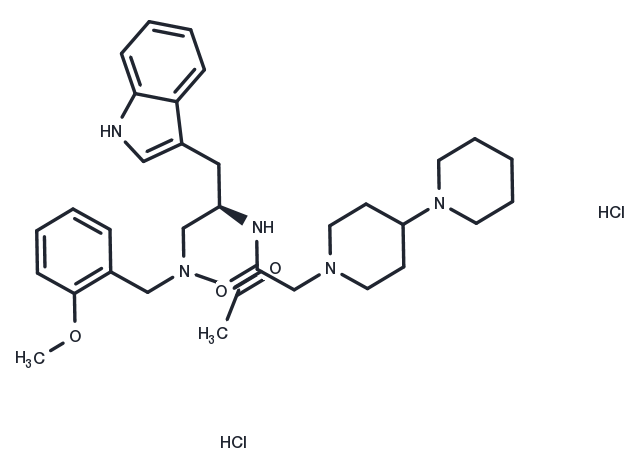Powder: -20°C for 3 years | In solvent: -80°C for 1 year


Lanepitant 2HCl is a non-peptide neurokinin-1 receptor antagonist with analgesic and anti-inflammatory activity.Lanepitant 2HCl inhibits the binding of Substance P to the neurokinin-1 receptor, inhibits neurogenic inflammation and pain transmission, and can be used in the study of painful neuropathic disorders, such as migraines.

| Pack Size | Availability | Price/USD | Quantity |
|---|---|---|---|
| 1 mg | In stock | $ 195.00 | |
| 5 mg | In stock | $ 483.00 | |
| 10 mg | In stock | $ 692.00 | |
| 25 mg | In stock | $ 1,080.00 | |
| 50 mg | In stock | $ 1,490.00 | |
| 100 mg | In stock | $ 1,970.00 |

| Description | Lanepitant 2HCl is a non-peptide neurokinin-1 receptor antagonist with analgesic and anti-inflammatory activity.Lanepitant 2HCl inhibits the binding of Substance P to the neurokinin-1 receptor, inhibits neurogenic inflammation and pain transmission, and can be used in the study of painful neuropathic disorders, such as migraines. |
| Synonyms | LY303870 dihydrochloride, LY 303870 dihydrochloride, LY-303870 dihydrochloride, Lanepitant dihydrochloride |
| Molecular Weight | 632.66 |
| Formula | C33H47Cl2N5O3 |
| CAS No. | 170508-05-1 |
Powder: -20°C for 3 years | In solvent: -80°C for 1 year
You can also refer to dose conversion for different animals. More
bottom
Please see Inhibitor Handling Instructions for more frequently ask questions. Topics include: how to prepare stock solutions, how to store products, and cautions on cell-based assays & animal experiments, etc.
Lanepitant 2HCl 170508-05-1 GPCR/G Protein Neuroscience Neurokinin receptor LY303870 dihydrochloride LY-303870 Lanepitant HCl LY 303870 Lanepitant LY303870 LY 303870 dihydrochloride LY-303870 dihydrochloride Lanepitant dihydrochloride inhibitor inhibit
